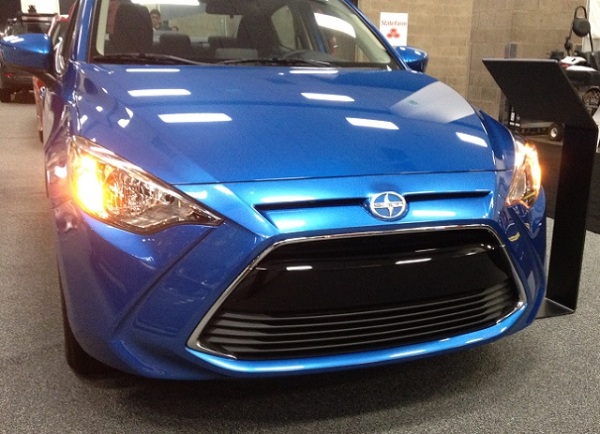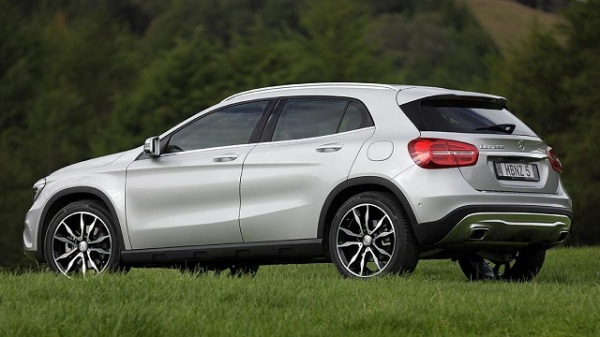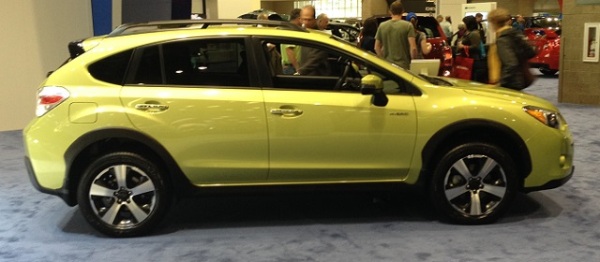2015 Seattle International Auto Show: New (Motor) Trends

“Hmm. That doesn’t look like a 2016 Prius.” (Orin O’Neill photos, except as noted)

Where did 2015 go? I spent most of it recuperating from a recurrence of a dormant MRSA infection which, among other things resulted in the loss of my right leg below the knee. I’ve recovered just in time to hit the Seattle Auto Show again. Happily, I can drive my car just fine with the prosthesis… no hand controls necessary! Which among other things means I could someday be in the market for new wheels (Transit Connect, perhaps?)
The story follows the jump, but if you don’t care there’s NINE YEARS’ worth of scooter-related awesomeness, respectfully submitted for your perusal.
SEATTLE — Have you looked closely at the Seattle Auto Show website? Yeah, it’s more tablet- and mobile-friendly, but the real news is at the bottom of each page, where it says “Copyright 2015 Motor Trend Auto Shows.” Yes, that Motor Trend. The monthly car magazine. The one you got a free 12-month subscription to if you bought your ticket online. Your guess is as good as mine as to what this will ultimately mean, but I’ve said for years that this show should aspire to greater heights than just offering up the latest hybrids and bazillion-dollar hypercars on the mezzanine. A North American debut or two, f’rinstance.
This year saw some changes in the look and feel of the show. Navigation among the various brands, which previously didn’t exist at all, was enhanced.

Not pavement. Carpet. There were also faux Interstate highway signs, but the ceiling at CenturyLink Events Center is so high, you wouldn’t have seen them without looking WAY up.
One thing I hope Motor Trend will address is this show’s propensity for NOT having newly-introduced, buzzworthy new cars.

This dude was the highlight of the Buick stand. But the Enclave on the turntable has been around for quite a while now.
Did you know Buick will soon be selling a really cool convertible?

2016 Buick Cascada convertible (Photo by John F. Martin for Buick)
You’re forgiven if you don’t. It’s not like there was a Cascada on display, or anything. MSRP is $33,990, which Buick eagerly points out is exactly $3,535 less than an Audi A3 Cabriolet. It’s been on sale in Europe for a while, and in all likelihood will be offered in China, a bigger market for Buick than the U.S. In fact, a recent announcement that all but two Buick models will eventually be sourced in China has Fox News Channel viewers (a demographic that skews even older than Buick’s traditional customer base) gnashing their teeth and rending their garments.

MINI Clubman is the biggest, most cognitively-dissonant model yet. (Photo: MINI USA)
Model year 2016 sees the introduction of a new MINI (they still tell me, all caps please) Clubman. That’s the station wagon with the dual rear doors. “The most versatile, charmingly sophisticated MINI we’ve ever made,” sez the MIMIUSA website. And the BIGGEST.
Was there one on the show floor? Nope. If you go to the MINI USA website you can build and price one, which I would take to mean you could go to a dealer and, um, BUY ONE. The ’16 Clubman looks to be roughly the size of the dearly departed Fourth Estate, my 1995 Ford Escort wagon. I like genuinely compact station wagons, but ones that sticker out in $30K territory are way too rich for my blood.
Well, the various iterations of BMW’s 4-wheeled fashion accessory have all been bigger than the original, and the newest version of what’s now called the MINI Hardtop is anything but. The upside is the addition of a 4-door Hardtop, which if you actually plan to have people riding in the back seat makes for easier ingress/egress. They did have one of those on display.

The 2016 Prius was introduced earlier this year in a lavish event in Las Vegas (Toyota USA photo)
The absence that really had me gobsmacked was the 2016 Toyota Prius. Toyota rolled out the seminal hybrid’s fourth generation in Las Vegas, of all places. (My invitation must’ve gotten lost in the mail.) With this new iteration, Toyota is trying to convince everyone that Prii are not dull, colorless cars for dull, colorless people. The new one kinda looks like the old one, but it’s drawn with the latest high-end styling cliches. A floating rear roof over hidden D-pillars, f’rinstance. The new Prius is also touted as being fun to drive. Okay.
But really, Seattle is effing PRIUSVILLE, for gosh sakes! They couldn’t have brought a mockup to display behind a velvet rope?

Chevy Volt, the car conservatives love to hate, is all-new for 2016
Chevrolet always used to be one of the worst offenders in not having recently- or about-to-be-introduced new models. Not so in 2015. Kudos to the bowtie brand for displaying a 2016 Volt, a 2016 Camaro and on the podium, a 2016 Cruze. Not to mention their new, Nissan-built Express City compact cargo van.
I was just disappointed there was no 2016 Spark.

2016 Chevy Spark (GM photo)
I remain rather fond of the Spark, not just because of its low price and high level of standard equipment, but because it’s an A-segment car in a market that could use more of them. The new Spark arrives on our shores in January. Where the old one was charmingly funky, this new one (debuting earlier this year in Europe and the U.K. as the Opel Karl and Vauxhall Viva, respectively) shows a level of sophistication and refinement most of the rest of the world has known in this segment, well, forever. The motorcycle-themed instrument cluster is gone, replaced by a more mature, refined display that’s part of a more mature, refined interior. I like this one mostly because it’s the spiritual descendant of the Geo Metro, a car that was quite popular in Seattle, back in the day. And because I would theoretically be able to afford ohe. 😉
Something I also hope will feature in future shows is more concept cars.

Let’s have more concept cars, like Lincoln’s stunning Continental
Center stage at Lincoln’s display was the stunning, controversial Continental concept. Yeah, it looks like a Bentley, but I think that’s better than looking like a Jaguar or Aston-Martin. Look closely, and you’ll notice the shape of the traditional Lincoln emblem is everywhere—the grille texture, the LEDs in the lights, and many other places. For that matter, the display itself incorporated that shape. There has been hope that the introduction of a production model (Lincoln says yes, but hasn’t said when) would herald a move away from Lincoln’s MKSomething-or-other model names. I’d love to see that.
The average transaction price for a new light vehicle purchase is $30,000 give or take. Unless you’re buying a new pickup truck.

Admittedly, the bottom line shown above was for a loaded crew cab Ford F-150. But that’s how a lot of pickup trucks are specced out these days.
In light of the fact that real incomes continue to fall, how are people affording to buy enough new vehicles to set 2015 sales record? Leasing is one way, but another is extending the terms of car loans. Seventy-two months, once rare, is now common. Some car loans even go 96 months. That’s eight years, folks. As Brock Yates once said, they don’t build cars like they used to, they build them much, much better; chances are the shiny 2016 model bought on the 8-year E-Z payment plan would still have considerable useful life left after the last payment, but most people aren’t as inclined to trade before the end of a car loan as they would be for a home mortgage. Especially since the value of a car goes down, not up.
And what are people buying? Not full- or mid-size sedans. They’re going for crossovers. I must say, I’m a bit surprised the term, which originated as industry jargon for an SUV built from a unibody instead of on a separate frame, has caught on with the general public.
The hottest of the hot, worldwide, are the small ones.

Honda HR-V
Honda’s HR-V set new sales records following its introduction earlier this year, and General Motors brought the Chevy Trax to the U.S. a lot sooner than would normally have been the case.

Fiat 500X (Photo: FCA US LLC)
The two most-anticipated small crossovers of 2015, however, were Fiat Chrysler’s Jeep Renegade and Fiat 500X. Built on the same platform, in Italy, they are aimed at different buyers. And neither are what you could call inexpensive.
The youth-oriented Renegade naturally can be specced out in Rubicon-themed Trailhawk trim, while the 500X has a Lounge version for those interested in cool sophistication. So, which one would I buy? For starters, on either I would skip the AWD, and spend some of the money saved on a good set of winter tires. AWD is the most utterly unnecessary passenger car feature EVER.
A Renegade Latitude and 500X Easy (the least expensive trims dealers are likely to have in significant numbers) sticker out within $1,000 of each other. Both include alloy wheels, numerous electronic and telematic gizmos and air conditioning (yes, in Seattle you need it). But if I had 22 large laying around and could only choose one of the FCA twins, I’d take the Fiat.

Jeep Renegade
Why? Well, the Renegade’s too damn precious, that’s why. The dashboard air vents look like goggles. The rubber mat in the console bin is a topo map of Moab, Utah. The big X in each taillight is supposed to make you think of Jerry cans, and the redline mark on the tachometer is a mud splatter. Good grief. Keeping in mind that few Renegades will ever venture any further offroad than a gravel driveway, it’s all a bit much.
Really, if I could choose anything in the segment, I’d get a Kia Soul+ and spend the three grand I save on a really nice vacation.

Sergio Marchionne
Sergio Marchionne (who has told everyone he pronounces his last name MAR-she-own), the CEO of Fiat Chrysler, has been doing a bang-up job of keeping his company in the media spotlight over the last year. Not satisfied with swallowing Chrysler whole, he had famously spent the earlier part of this year sending emails to CEOs of other car companies expressing his urge to merge. The industry wastes billions in capital, he says, urgently. Four-cylinder engines are all alike, he maintains, so why the h-e-double-toothpicks is every car company engineering their own? When GM CEO Mary Barra rebuffed his overtures to combine FCA with GM, Marchionne wouldn’t take no for an answer, beating the bushes in the financial community for partners to do what sure looked like a hostile takeover. Marchionne’s ardor has cooled somewhat lately, but he still hopes to get some kind of merger deal done before he retires in 2018.
You know Mazda opened a new factory in Mexico earlier this year, right? That factory was slated to build the Mazda2 and Mazda3, but the company has decided not to sell the former in the U.S. They didn’t sell all that many, and really, a Mazda3 is not that much more expensive.

Mazda-built Scion iA: Gone fishin’
However, a Mazda2 will still be sold in the U.S., but it will be wearing a Scion badge. And it will not be a hatchback, but a sedan called the iA. Which is downright fugly, actually. Think Toyota Echo crossed with a largemouth bass. Also debuting at Scion for 2016 is the iM, a derivative of the Euro-market Toyota Auris hatchback that replaces the boxy xB. Both are attempts to stanch Scion’s continuing downward sales spiral, but given the brand’s youth-oriented target audience’s general lack of interest in cars and driving, they might be better off selling smartphones.

Youth-oriented Scion iM was mostly being checked out by old guys
Speaking of Mazda and Toyota, they are now an item. The company’s CEOs recently changed their relationship status on Facebook, and hope to find the usual synergies and economies of scale that come with jointly developing new products. Toyota CEO Akio Toyoda is particularly smitten with Mazda’s forward-looking design and product philosophies, while Mazda gains access to Toyota’s hydrogen fuel cell and hybrid powertrain technologies. “This is an engagement announcement, not a marriage announcement,” Toyoda said. Really, that’s what he said!
A development that had been whispered about for a while came to pass in July: Mitsubishi announced the impending closure of its Normal, Ill. assembly plant. Well, it’s not like people were lining up around the block to buy Mitsubishi cars and trucks. Still, after years of steady sales decline, Mitsubishi has been on a slightly upward trajectory in the U.S. lately. Not necessarily because of stellar product (see Outlander Sport, Mirage). I’m guessing at least part of the reason for their imporved fortunes is the departure of Suzuki Auto from the U.S. market, especially their dealers’ fondness for subprime car loans. The Mitsu dealer where I live recently sent me a letter saying I (of ruinous finances and a FICO score well into negative territory) was pre-approved for a $35,000 car loan. I must admit, I would’ve been more than a little curious to see what kind of an interest rate they’d have given me, but still.
As did the other Japan-based car companies, Mitsubishi decided to build a factory in the U.S. to mitigate the effect of a strong yen. Well, guess what? Nissan recently announced that some Rogue crossovers sold in the U.S. will be built in… wait for it… Japan! These days your greenback dollar is worth about ¥120, way more than just a few years ago. So building in Japan is no longer the financial bath it once was, for the time being anyway.

I’d much rather have a Mercedes=Benz GLA 250 than a Mitsubishi (Mercedes-Benz Australia photo)
The 35 grand the Mitsu dealer wanted to lend me could actually get you into a Mercedes-Benz; that would be the GLA 250, which boasts a base sticker price of $31,300. Upon seeing one for the first time at last year’s show, I found myself really, really liking it. As I said earlier, crossovers are big these days, and in today’s context the price is pretty close to the industry average.
However, you could get a base Subaru XV Crosstrek for about ten thou less (or even the hybrid, new for 2016, and get about five grand in change). It will depend on how important a designer label is to you. Of course, Bellingham is Subaru/Prius central, so a jacked-up Subaru hybrid will send your ‘Hamster cred into the stratosphere.

Subaru XV Crosstrek Hybrid: Off-the-charts Bellinghamster cred
Okay, you know about the two guys who hacked a Jeep Cherokee while a writer for Wired was driving it, right? FCA admitted there was a problem and came up with a fix. Which is being distributed by mail, ON THUMB DRIVES! Good grief. As a former code slinger, I’m not at all surprised at the failure of corporate entities to understand data and network security, but COME ON!!! It’s not a new thing! And thumb drives are about the least secure medium out there… it would be so easy for these things to be intercepted, spoofed, and sent on their way to cause who knows what kind of mayhem. A cassette deck is about as high tech as the More Expensive Ford Taurus with a Different Grille gets, and stuff like this makes me like that more and more.
Volkswagen is having a year to remember, isn’t it? It started out well, with the Mk.VII Golf winning North American Car of the Year AND MT Car of the Year. These accolades may or may not have had something to do with VW’s meteoric rise in 2015 North American sales, but it certainly helps that the Golf is a really nice car, I daresay even a bargain at its premium price.

While I don”t have any hard numbers, I know of lots of Volkswagens that got traded in for Subarus. Even before Dieselgate…
But along came Dieselgate. VW got its wrists severely slapped by the Environmental Protection Agency (and also faces a criminal investigation by the Justice Department) for allegedly including a software hack in TDI Clean Diesel® models that circumvents emissions rules under any conditions other than emissions testing. VW admits this hack is present in 11 million vehicles worldwide.
There’s a part of me that admires the sheer chutzpah of such a plan, but really, how is is possible ANYONE at VW thought they could get away with it? VW CEO Martin Winterkorn fell on his sword in late September; each day brings a new statement from VW management about how the company plans to deal with this. Reprogram the ECUs? Retrofit urea injection (employed in most other diesel cars to reduce NOx emissions)? How long will whatever they decide on take? Months? Years? The cost could be staggering—between fines, shareholder lawsuits (this debacle erased roughly 1/3 of the VW Group’s market capitalization) and class actions by owners of affected vehicles, the total bill could come to many, many billions of dollars. Especially if the EU and major Asian governments become involved.
VW recently withdrew applications to the EPA to certify its 2016 diesel models; this could well mean the end of the line for diesel-engined passenger cars at VW. It might even mean the end of VW in the U.S.
There used to be a lot of buzz about when a Chinese car company would set up shop in the U.S. Such buzz has since shifted to when Apple is going to offer a car for sale (the Silicon Valley grapevine is saying 2019). Well, for the last few years the company has been hiring people with deep auto industry experience. As is their usual practice, Apple isn’t saying what they have in mind, but the rumor mill points to a driverless car. *Sigh* My most recent Apple experience required a 120-mile round trip to an Apple Store because my attempt to upgrade my iPhone to iOS 9 choked. Or, as I’ve been seeing on message boards, it “bricked” (as in, made the device a useless brick… “brick” is now a verb). Steve Jobs would never have put up with that. Steve Jobs will not be around when people’s [Apple symbol]CARS brick, with their owners in them. Because Steve Jobs is still dead. ![]()




Comments are closed.